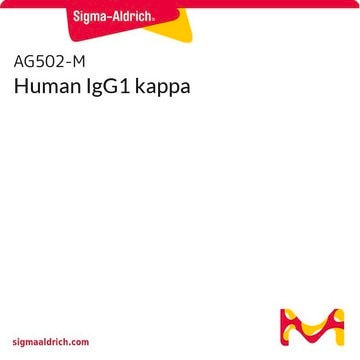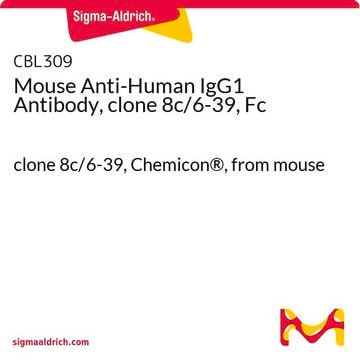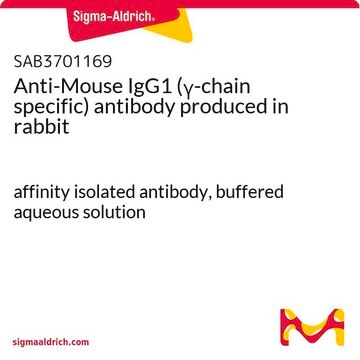This antibody is specific for an epitope expressed in the Fc region of human IgG1. It does not cross-react is other human IgG subclasses. It has not been tested for cross-reactivity with other species.
I2513
Monoclonal Anti-Human IgG1 antibody produced in mouse
clone 8c/6-39, ascites fluid
Sinonimo/i:
Monoclonal Anti-Human IgG1 (Fc specific)
Scegli un formato
Scegli un formato
About This Item
Prodotti consigliati
Origine biologica
mouse
Coniugato
unconjugated
Forma dell’anticorpo
ascites fluid
Tipo di anticorpo
secondary antibodies
Clone
8c/6-39, monoclonal
contiene
15 mM sodium azide
tecniche
indirect ELISA: 1:400
Isotipo
IgG2a
Condizioni di spedizione
dry ice
Temperatura di conservazione
−20°C
modifica post-traduzionali bersaglio
unmodified
Cerchi prodotti simili? Visita Guida al confronto tra prodotti
Categorie correlate
Descrizione generale
Specificità
Applicazioni
- direct hemagglutination(HA)
- hemagglutination inhibition(HAI) assays
- enzyme linked immunosorbent assay (ELISA)
- immunofluorometric assay (IFMA)
- immunofluorescence
- cell-based assays for the detection of IgG subclasses of acetylcholine receptor (AChR) antibodies
Azioni biochim/fisiol
Stato fisico
Stoccaggio e stabilità
Esclusione di responsabilità
Non trovi il prodotto giusto?
Prova il nostro Motore di ricerca dei prodotti.
Codice della classe di stoccaggio
10 - Combustible liquids
Classe di pericolosità dell'acqua (WGK)
nwg
Punto d’infiammabilità (°F)
Not applicable
Punto d’infiammabilità (°C)
Not applicable
Scegli una delle versioni più recenti:
Certificati d'analisi (COA)
Non trovi la versione di tuo interesse?
Se hai bisogno di una versione specifica, puoi cercare il certificato tramite il numero di lotto.
Possiedi già questo prodotto?
I documenti relativi ai prodotti acquistati recentemente sono disponibili nell’Archivio dei documenti.
I clienti hanno visto anche
-
Hi, I was wondering if this product I2513 has been tested for crossreactivity with other species, specifically with mouse IgG. Regards, Jean
1 risposta-
Utile?
-
Filtri attivi
Il team dei nostri ricercatori vanta grande esperienza in tutte le aree della ricerca quali Life Science, scienza dei materiali, sintesi chimica, cromatografia, discipline analitiche, ecc..
Contatta l'Assistenza Tecnica.
















